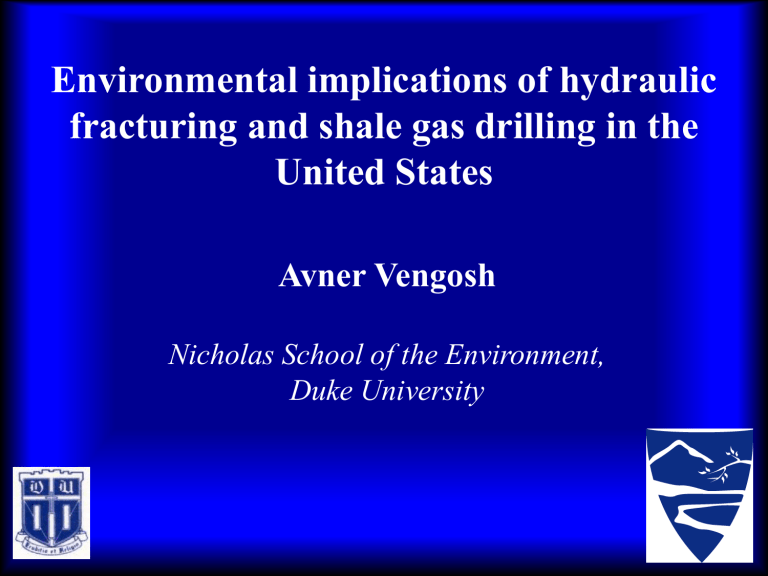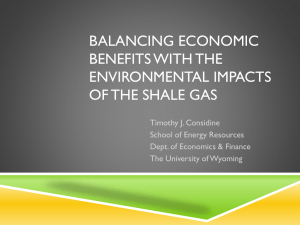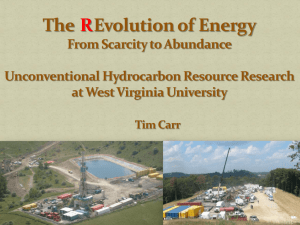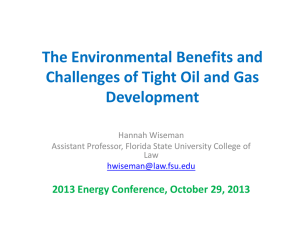Environmental implications of hydraulic fracturing and shale gas

Environmental implications of hydraulic fracturing and shale gas drilling in the
United States
Avner Vengosh
Nicholas School of the Environment,
Duke University
Rob B. Jackson
Nathaniel R. Warner*
Stephen Osborn,
Adrian Down
Nicholas School of Environment
Duke University
The take-home messages of this talk:
• Shale gas exploitation through hydro-fracturing may save America from foreign oil but seems to cause methane contamination in shallow drinking water wells in the Appalachian Basin.
•No evidence, so far, for groundwater contamination from produced/flowback water.
• Disposal of produced water from shale gas wells poses a significant risks to the ecological systems and waterways in Pennsylvania.
• Sustainable and long-term shale gas developments will need to accommodate the environmental issues associated with shale gas drilling and hydro-fracturing.
Energy production in the USA (2009)
Renewable
(11%)
Nuclear
(11.9%)
Coal
(30.6%)
Crude oil
(16%)
Natural gas
(30.5%)
Total production= 73 quadrillion Btu
EIA- US Energy Information Administration
What is hydraulic fracturing (fracking)?
The critical role of shale gas production in the U.S.
Estimates of undeveloped technically recoverable shale gas and shale oil resources (total 750 trillion cubic feet)
Source: IEA (2011)
Global shale gas basins
Global Gas Resource
• World: ~250 years coverage at current demand
• Large unconventional gains anticipated
4.8
8.1
1.3
North America*
1000 TCF
30
25
20
Unconventional
15
10 Conventional
5
0
World
2.6
Latin America
Europe
OECD
Africa
2.3
Source: IEA; * Includes Europe Non OECD
4.9
Middle East
Russia/Caspian*
4.1
Asia Pacific
Shale-gas drilling and hydro-fracturing
Montrose, Susquehanna, Pennsylvania
(June, 2011)
The Marcellus Shale, Appalachian Basin
Map of The Marcellus (red) and none-Marcellus (blue) wells drilled in Pennsylvania in 2010
(PA DEP)
Map
1,386 gas and oil wells were drilled in PA in 2010
Major stages in shale gas production:
• Pad, impoundment and road construction; heavy truck traffic and heavy equipment;
• Drilling – drilling rigs require power from diesel engines; noise…
• Fracturing – during this stage, large amounts of water and fracturing fluid are pumped into the well to create fractures for the gas to escape from the shale;
• A portion of the fluid (30-40%; flowback) is returned into a wastewater impoundment where it is trucked for disposal/ treatment; once the well in operation – generation of produced water that need to be disposed;
(from PA_DEP report on potential gas emission)
Major stages in shale gas production:
• Flaring –testing the gas well before production. Emissions are created from the burning of gas and atmospheric venting of noncombusted gas;
• Condensate Tanks – gas pumped from the well may contain brine and other volatile organic compounds that condense into collection tanks;
• Compressor stations – waw gas is piped from wells to compressor stations where the gas is pre-treated and compressed; building a network of gas pipes through the region.
(from PA_DEP report on potential gas emission)
Key environmental risks associated with shale gas drilling and hydro-fracturing
Methane contamination of drinking water wells
Contamination by fracturing fluid
Fugitive emissions of methane to the atmosphere
(transportation, spills, disposal)
Water use, lost
(7-15 million liter per well)
Air pollution associated with different stages of gas production
Disposal of fracturing fluids/produced water
Health implications, quality of life
(traffic, noise)
Release of of fracturing fluid chemicals (spills, transportation)
What are the environmental risks associated with shale gas drilling and hydro-fracturing?
Water
• Do we have enough water?
•
Does shale gas drilling and hydro-fracking cause contamination of drinking water wells?
• Does produced water disposal cause long-term ecological effects and health risks?
Do we have enough water?
•
Drilling – 230,000 to 3,780,000 liter per well ;
•
Fracking – 7.6 to 15.1 million liter per well
1400 wells per year, like in the Marcellus
Shale, means 10-20 million cubic meter per year
•
(Durham, NC consumes 27-34 MCM/year)
Energy Content and
Instantaneous Water Efficiency
Bureau of Economic Geology
• 1 bbl oil ~ 5.9 MMBtu
7
• 1 MCF gas ~ 1 MMBtu
6
• 1 ton lignite ~ 9-18 MMBtu
5
Gas Production
Water Use
• 1 lb U ~170 MMBtu
4
3
• Gas (2010): 2.3 gal/MMBtu
100
80
60
40 loading of 0.8 lb/gal – add 20% to fracing
• Total Gas: 2.9 gal/MMBtu
2003 2005 2007 2009
Calendar Year
17
0
20
Does shale gas drilling and hydro-fracking cause contamination of drinking water wells?
Figure from Scientific American Magazine, November 2011
The research methods:
Duke Research activities (updated to August 2011):
1. Sampling over 200 shallow private wells in eastern PA, NY;
2. Sampling produced waters from several gas wells in PA and
NY;
3. Analysis of methane in private wells – concentrations, isotopes
( d
13 C
CH4
, d
2 H
CH4
)
4. Analysis of the chemistry and isotopes of groundwater associated and not associated with gas wells in PA.
5. Analysis of the Marcellus Shale brines
6. Chemical (major and trace elements) and isotopic ( 87 Sr/ 86 Sr,
11 B/ 10 B, 18 O/ 16 O, 2 H/H) measurements.
7. Measurements of naturally occurring radium ( 226 Ra, 228 Ra) nuclides
Isotopic fingerprinting of methane source d
13
C –
13
C/
12
C
CH
4 d
2
H –
2
H/H
Proceedings of National
Academy of Sciences,
May 17, 2011
Duke research in Pennsylvania and New York
Hydro-geological cross section
Definition of active versus non-active wells:
Private wells located <1km from a shale gas had typically higher methane
(based on about 60 wells)
Definition of active versus non-active wells:
Private wells located <1km from a shale gas had typically higher methane
Lockheaven Fm
Catskill Fm
(based on 91 wells)
Non-active
Non-active
Methane sources?
Active
A distinction between active wells with a thermogenic isotopic fingerprint and nonactive wells with a mixed composition
Active
Methane sources ?
Biogenic
Thermogenic
Methane sources ?
Dry thermogenic gas
Biogenic
Possible mechanisms for leakage of stay gas to water resources
Figure from Scientific American Magazine, Nov 2011
Possible mechanisms for leakage of stay gas to water resources
From Penoyer, (2011), Natural Resource Stewardship & Science
No apparent chemical contamination: no differences between active to non active wells
No apparent isotopic differences between active to non active wells
Strontium isotopes: a sensitive tracer for mixing with produced/flowback water
A lower 87 Sr/ 87 Sr for non-mixed fracturing fluids
The sensitivity of strontium isotopes to mixing with fracturing fluids and backflow brines
Fracturing fluids-formation water mix
Boron isotopes: differentiation from other contaminant sources
Occurrence of saline groundwater enriched in barium in shallow aquifers
(Warner, et al., Geochemical evidence for natural migration of Marcellus-like brine to shallow drinking water in Pennsylvania , submitted to PNAS)
Possible hydraulic connectivity between deep
Marcellus-like brine to shallow aquifers
Can deep gas and brine in northeastern PA flow to the surface? Is it related to fracking ?
Deep water displacement
Results of the study indicate:
1. High methane concentration in active wells (<1 km from gas well) are associated with a distinguish chemical and isotopic composition identical to the Marcellus gas in production wells while wells located >1 km had lower methane and different composition;
2. Active wells were not contaminated by chemicals derived from contamination of produced waters.
Does produced water disposal cause longterm ecological effects and health risks ?
What’s in produced water?
• Salinity (Marcellus brine – 250,000 mg/L (10 fold seawater);
• High bromide, bromide presence in water enhances the formation of carcinogenic disinfection by-products (e.g., trihalomethane) upon chlorination of downstream potable water;
• High concentrations of toxic elements (barium, arsenic, selenium, lead);
• High concentrations of naturally occurring radioactive materials (NORMs); ( 5000 pCi/L , drinking water standard=5 pCi/L)
•Hydrocarbon residuals, oil, organics
Management of produced water
• Inject underground through a disposal well (onsite or offsite),
• Discharge to a nearby surface water body,
• Haul to a municipal wastewater treatment plant,
• Haul to a commercial industrial wastewater treatment facility,
• Reuse for a future fracking job either with or without treatment.
Deep well injection
In 2009 about 140 million gallon were injected in Ohio;
In 2011 a significant increase; nearly 50% is coming from PA where PA last May banned shipment of drilling waste to its sewage treatment plants. Ohio 181 injection wells were in full capacity.
Trigger for earthquakes ? (Oklahoma, 5.6R; Arkansas
4.7R; Youngstown, Ohio 2.7R; 4.0R (12/31/2011)
Source: Cidney Christie, Duke
The effects of brine disposal: (preliminary results)
High salinity in the river water
(up to 500m downstream)
The effects of brine disposal: (preliminary results)
High bromide in the river water
(up to 500 m downstream)
•
Long-term salinization of fresh water resources: high chloride and bromide in surface water enhance the formation of carcinogenic disinfection by-products (e.g., trihalomethane, bromodichloromethane) in potable water.
The effects of brine disposal: (preliminary results)
High barium in the river water
(up to 500 m downstream) background
The effects of brine disposal: (preliminary results)
Accumulation of radionuclides in river sediments (up to 300m downstream); implications for longterm radium bioaccumulation.
background
A roadmap to clean energy
Mountaintop coal mining
streams contamination
Installation of scrubbers to prevent air pollution (“clean coal”) enhances contaminants’ accumulation in coal combustion products
water contamination
Shale gas drilling and hydro-fracturing
stray gas emission, methane contamination of shallow aquifers , produced water disposal
Further reading:
Osborn, S., Vengosh, A. Warner, N. Jackson, R. (2011). Methane contamination of drinking water accompanying gas drilling and hydro-fracking. Proceedings of the National Academy of Sciences,
108, 8172-8176.
Acknowledgements:
• Frank Stanback, North Carolina
• National Science Foundation, Geobiology & Low-Temperature
Geochemistry Program
• Nicholas School of Environment, Duke University
Further information: http://sites.nicholas.duke.edu/avnervengosh/
NSF Workshop at Duke (January 9, 2011) : Environmental and Social Implications of Hydraulic Fracturing and Gas
Drilling in the United States: An Integrative Workshop for the
Evaluation of the State of Science and Policy http://www.nicholas.duke.edu/hydrofrackingworkshop2012/ workshop








